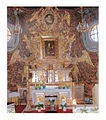Gąsawa
Gąsawa | |
|---|---|
Village | |
 Saint Nicholas Church | |
| Coordinates: 52°46′N 17°45′E / 52.767°N 17.750°E | |
| Country | |
| Voivodeship | Kuyavian-Pomeranian |
| County | Żnin |
| Gmina | Gąsawa |
| Population | |
| • Total | 1,400 |
| Website | http://www.gasawa.pl/ |
Gąsawa [ɡɔ̃ˈsava] (Template:Lang-de, 1939–1945 Gerlingen) is a village in Żnin County, Kuyavian-Pomeranian Voivodeship, in north-central Poland. It is the seat of the gmina (administrative district) called Gmina Gąsawa. It lies approximately 10 kilometres (6 mi) south of Żnin and 43 km (27 mi) south-west of Bydgoszcz. The village has a population of 1,400.
Gąsawa received the city rights in 1388 and lost them in 1934.
It is famous as the place of the assassination of Leszek I the White, prince of Poland (November 23, 1227).
In 1600 Gąsawa hosted the Lubrański Academy (Template:Lang-pl) which temporarily moved out of plague-stricken Poznań.
The main tourist attraction in Gąsawa is the 17th century wooden St. Nicolas Church with a unique collection of multi-layered mural paintings, the earliest from the 17th century, and the most recent from 1807.[1]
The church itself, a larch construction with a slate roof, was in such a bad state around 1850 that local officials asked the regional Prussian government to allow the church to be dismantled and build a new one instead. The response gave permission to only overhaul the building. Existing wall paintings were covered with a layer of reed and ordinary plaster, and forgotten for some 150 years.[2][3]
The town name was spelled "Gonzawa" "Gonsawa", "Gassawa", etc. in some old documents.[4]
Gallery
-
Coat of arms of Gąsawa.
-
St. Nicolas church in Gąsawa: main altar
References
- ^ "Archived copy". Archived from the original on 2007-09-26. Retrieved 2007-07-03.
{{cite web}}: CS1 maint: archived copy as title (link) Iconographic Baroque mural paintings in a wooden church accessed 3 July 2007 - ^ [1] Saint Nicolas' Church in Gasawa. accessed 7 July 2007
- ^ [2] Monuments of Sacred Architecture, Żnin county official website accessed 7 July 2007
- ^ Wuttke, Heinrich (1 January 1864). "Codex diplomaticus magni ducatus Posnaniensis". Fries – via Google Books.




